
|
|
|
Jeep FAQ How-To Articles Quick Reference Product Reviews My Buildup Random Home |
Well let's discuss rear ends. Unfortunately since this is a family board, I mean the differential underneath your Jeep. I've found many people will tear into just about anything, except an axle. There's no need to be scared of differential work. There's really not nothing too it. That being said, differential work is not for everyone, if you do all your own work, you can handle it, if you pay people to do much of your work, best leave it alone. I'm going to start with some basics, to help everyone understand some of the how and whys of differentials. Ok let's start with the gear ratio. The ratio is determined by the number of teeth on the ring gear divided by the number of teeth on the pinion gear. Say a TJ Dana 30 axle, the ring gear would have 43 teeth, and the pinion would have 14 teeth. 43/14 = 3.07. As the gear ratio goes numerically higher, the pinion will shrink. A 4.56 pinion (Again TJ Dana30) will have 9 teeth, while the ring gear 41 teeth, 41/9 = 4.56. For reference, here is a 3.07 TJ Dana30 pinion, and a TJ Dana30 4.56 pinion. 3.07 on the left, 4.56 on the right. 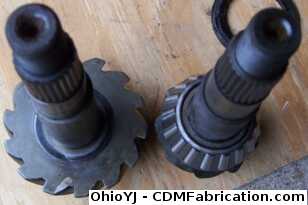 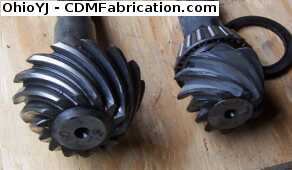 As the gear ratio goes numerically higher, the gear set becomes weaker. As you can see the pinion gets small quick, so don't just jump straight to 6.72. Next thing, you'll notice the TJ Dana30 has a 4.56 ratio available, but a TJ Dana44 only has a 4.55 ratio available. This has to do with the physical size difference between the two, sometimes you can get the same number of teeth on the gear sets, and sometimes you can't. As already mentioned the 4.56 TJ Dana30 has 41 ring gear teeth, 9 pinion gear teeth. The Dana44 4.55 ratio has 50 ring gear teeth, and 11 ring gear teeth. Don't freak out though, this is normal, the general rule of thumb is the ratios have to be within 3%. It not always possible to get the exact same ratio, I've run into an instance where one axle had to be 4.09, while the rear had to be 4.11. Many axles, *cough* Dana *cough* need a different carrier at a certain break point. Let's use the TJ/CJ Dana44 as an example. The 2.87-3.73 ratios use one carrier; the 3.92-5.38 ratios use a different carrier. This goes back to the physical size of the pinion gear. This is a rough drawing, 2.87-3.73 carrier on the left, 3.92-5.38 carrier on the right:  Basically once you reach 3.92 the pinion has gotten so small, you have to actually physically move the ring gear closer to it for the teeth to still mesh. Now there is an alternative to changing carriers with the gear ratios. Just in case anyone still makes them, DO NOT use ring gear spacers. There are way too many negatives to ring gear spacers, and these are just the wrong way of doing things. For some applications you can order thick, standard, or thin ring gears. From the example above, say you had a 3.73 ratio in your Dana44, and you want to install a 5.38 ratio without changing the carrier, you could order a thick ring gear to make up the difference between the carriers. It also works the other way, let's say you have a 5.38 ratio, and want to go to a 3.73, you could use a thin ring gear to gain the space for the larger 3.73 ratio. This is a rough drawing of ring gear differences: 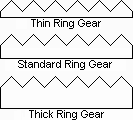 Time to get into the gear setup that is if you are still reading this super long post... Everyone is quick to chime in with if you don't set the gears up absolutely perfect the rear end will self destruct instantly, and burst into flames, ok I added the last part. To do any real damage you'd have to be so far off it isn't funny. Worse case your gear setup whines a little and you know to go back in there and adjust it some. Or you eat a pinion bearing, which will make noise usually and give you plenty of warning, its time to try again. I might get flamed for this, but rear axle setup just isn't as critical as everyone makes it out to be. I can't tell you how many old school mechanics setup most of their axles by feel. My first axle I rented all the special tools and such, and got a good feel for how things should feel, done more than I can count from that point forward by feel. Never had to re-adjust anything. Now I'm not recommending you just wing it, far from it. Just trying to point out, its not super critical like everyone tries to make it seem. First gear setup you do, you should rent the tools just to be safe. Now this isn't going to be a how-to, it's more to roughly explain what's involved in gear setups, and to help explain things like backlash, and pinion preload. When disassembling the axle, note which way the bearing caps come off, you want them to go back on just how they came off, they usually have arrows on them, just make sure they point the same direction when you put them back on. Most all pinions will use a shim to change the pinion depth. In the picture below, the pinion depth shim is in blue: 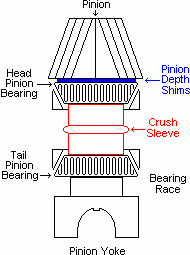 Pinion depth is where the pinion rides on the ring gear.  Many times the original shims off the old pinion will be correct, you can use the starting point engraved on the pinion head, but for me 9 times out of 10 the original shims will be correct. Getting proper pinion depth ensures you don't have any interference issues, achieve an acceptable wear pattern, and relieves stress on the pinion and ring gear. Pinion bearing preload is important thing to understand, whether you are setting up your axle, or just changing a pinion seal. Crush sleeves are found in many axles, so we'll talk about those first. First thing to realize is, THERE IS NO TORQUE VALUE FOR THE PINION NUT! So don't ask for a torque value, it's just not that simple. Most books will give a figure like 100 - 500 ft-lbs. It's a broad range, as the proper torque is when the correct pinion bearing preload is achieved, it could be 150 ft-lbs, could be at 275 ft-lbs. When using a crush sleeve, the crush sleeve is actually crushed some to get the pinion bearings to seat into the bearing races. This animation will help some: 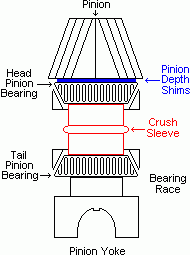 Think of pinion preload as the amount of drag on the bearings. You should not be able to reach under there and just spin the pinion freely; it should have some drag on it. The bearings are preloaded to ensure there is no lateral movement. Any movement is a bad thing, and could damage the gears, and pinion bearings. The key is to tighten the the pinion nut until you get all the play out, then you keep tightening it in very, very small increments, you want to tighten it till you have just a slight drag on the bearings. An inch pound wrench will help verify you have proper preload on the bearings. If you get to much preload you will cause pre-mature wear to the pinion bearings. The catch here is that, a crush sleeve is a one shot deal, if you get too much preload you can't just back the pinion nut off some, you have to start over with a new crush sleeve. This is why you shouldn't just undo with pinion nut and replace a pinion seal, as you are messing with the pinion bearing preload when you re-tighten the pinion nut. Now some axles have a solid spacer (you order these in different sizes) or shims to set the pinion preload. For example instead of a crush sleeve, a YJ/XJ high pinion Dana30 uses a stack of shims in between the pinion bearings to adjust the pinion bearing preload, these axles are sweet to setup, crush sleeves suck. Another key point here is that obviously since you can crush a crush sleeve, it is sort of a weak point. If you are going for the ultimate in strength, you should set the pinion preload with the crush sleeve, then measure the crushed crush sleeve, and order a solid spacer to use. However for most everyone a crush sleeve is just fine. The next part of a gear setup is install the ring gear, and its time to play with backlash settings. Backlash is the amount of play between the teeth of ring gear, and the teeth of the pinion gear.  If the gears are too tight, they will whine, and create excessive heat. To much and you place excessive stress, on things. On most axles the carrier will use shims, usually on the outside of the bearings, to place preload on the carrier bearings, and move the ring gear closer or farther way to the ring gear as necessary. 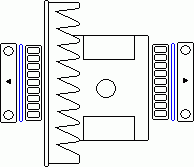 As you move the ring gear closer to the pinion, the backlash will get tighter, as the ring gear moves away from the pinion the backlash will increase. This can get old, as it results in many adjustments, put the carrier in, remove it change the shims around some, put the carrier back in, still not quite right, so pull it out again. A feel style dial indicator with a magnetic base will help ensure you have achieved proper backlash. Also note that you must torque the caps down each time when measuring backlash. Also the carrier should not slide in real super easy; you should have to push it in firmly, to make sure the carrier bearings have some preload on them. There are a few axles out there that don't use shims, take many Chrysler axles or a 14-bolt for example; they use these really trick "automatic" adjusters. They are essentially big nuts on both sides of the carrier that can be loosened and tightened as need to adjust backlash, these axles are sweet to setup, shims suck. As stated before this is write-up is just supposed to help explain ring and pinion ratios, and things like pinion depth, pinion bearing preload, backlash, etc. Hopefully to help give everyone a little better understanding of how a differential works, and what's involved in setting one up. |
| © Copyright 2006 - 2025 Mike Lee | |